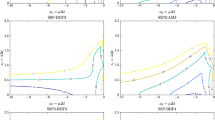Abstract
The numerical solution of time-dependent ordinary and partial differential equations presents a number of well known difficulties—including, possibly, severe restrictions on time-step sizes for stability in explicit procedures, as well as need for solution of challenging, generally nonlinear systems of equations in implicit schemes. In this note we introduce a novel class of explicit methods based on use of one-dimensional Padé approximation. These schemes, which are as simple and inexpensive per time-step as other explicit algorithms, possess, in many cases, properties of stability similar to those offered by implicit approaches. We demonstrate the character of our schemes through application to notoriously stiff systems of ODEs and PDEs. In a number of important cases, use of these algorithms has resulted in orders-of-magnitude reductions in computing times over those required by leading approaches.
Similar content being viewed by others
References
Ablowitz M. J., Clarkson P. A. (1991). Solitons, Nonlinear Evolution Equations and Inverse Scattering, London Mathematical Society Lecture Note Series, Cambridge University Press, Vol. 149.
Abramowitz M., Stegun I. A. (1964). Handbook of Mathematical Functions Dover.
Agrawal, G. P. (1995). Nonlinear Fiber Optics, Second Edition. Academic Press.
Baker, G. A. Jr., and Graves-Morris, P. (1981). Padé Approximants Part 1: Basic Theory, Encyclopedia of Mathematics and Its Applications, Vol. 13 Addison-Wesley.
Belousov, B. P. (1959). A periodic reaction and its mechanism, Ref. Radiats. Med., Medgiz p. 145.
Birkhof, G., and Varga, R. S. (1965). Discretization errors for well-set Cauchy problems I. J. Math. Phys. 44, 1-23
Boyd, J. P. (2001). Chebyshev and Fourier Spectral Methods, Second Edition. Dover.
Bruno O. P., Reitich F. (1994). Approximation of analytic functions: a method of enhanced convergence. Math. Comp. 63: 195–213
Field R. J., Körös E., Noyes R. M. (1972). Oscillation in chemical systems II. Thorough analysis of temporal oscillations in the bromate-cerium-malonic acid system. J. Amer. Chem. Soc. 94: 8649–8664
Hairer E. (1980). Unconditionally stable explicit methods for parabolic equations. Numerische Mathematik 35: 57–68
Hairer, E., and Wanner, G. (1996). Solving Ordinary Differential Equations II, Second Edition. Springer.
Hochbruck M. Lubich C., Selhofer H. (1998). Exponential integrators for large systems of differential equations. SIAM J. Sci. Comput. 19: 1552–1574
http://na.uni-tuebingen.de/na/software.shtml
John, F. (1982). Partial Differential Equations, Fourth Edition. Springer-Verlag.
Press W. H. et. al. (1996). Numerical Recipes in Fortran 77: The Art of Scientific Computing. Cambridge University Press.
Ruoff P., Varga M., Körös E. (1988). How Bromate Oscillators are Controlled. Acc. Chem. Res. 21: 326
Sommeijer, B. P. A Runge-Kutta-Chebyshev subroutine, available from Netlib (http://www.netlib.org).
Sottas G. (1984). Rational Runge–Kutta methods are not suitable for stiff systems of ODEs. J. Comp. Appl. Math. 10: 169–174
Srivastava A. and Paveri-Fontana S.L. (1986). Numerical experiments on the Rational Runge–Kutta Method. Comp. Maths. Appls. 12A: 1161–1170
van der Houwen P.J. (1977). Construction of integration formulae for initial value problems. North Holland, Amsterdam.
van der Houwen P. J. (1996). The development of Runge-Kutta methods for partial differential equations. Appl. Numer. Mathe. 20: 261–272
Verwer J.G., Hundsdorfer W.H., Sommeijer B.P. (1990). Convergence properties of the Runge–Kutta-Chebyshev method. Numer. Math. 57: 157–178
Wambecq A. (1978). Rational Runge–Kutta methods for solving systems of ordinary differential equations. Computing 20: 333–342
Wambecq A. (1976). Nonlinear methods in solving ordinary differential equations. J. Comput. Appl. Math. 2: 27–33
Zhabotinskii A.M. (1964). Periodic liquid phase oxidations. Dokl. Akad. Nauk SSR 157: 362–365
Author information
Authors and Affiliations
Rights and permissions
About this article
Cite this article
Amundsen, D.E., Bruno, O. Time Stepping Via One-Dimensional Padé Approximation. J Sci Comput 30, 83–115 (2007). https://doi.org/10.1007/s10915-005-9021-4
Received:
Accepted:
Published:
Issue Date:
DOI: https://doi.org/10.1007/s10915-005-9021-4




